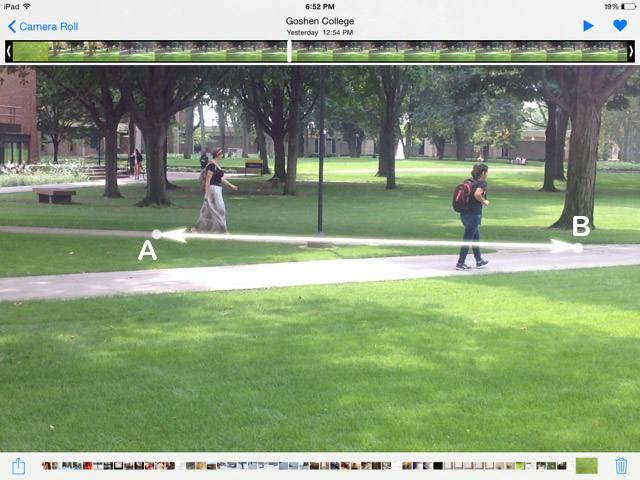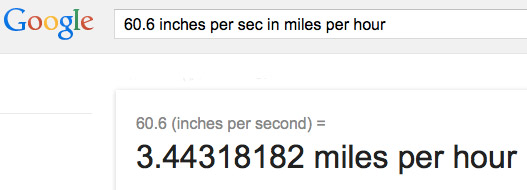Measuring... speed
- How's the Google Drive sharing going?
- Review of Aristotle assignment
- Measuring speed from a video...
Reading/Writing about Aristotle
With this theory modern science would completely disagree.
I also agree with Aristotle that everything is made up of elements, and that in order to understand an object, we must understand its elements.
I also thought about how Aristotle never seemed satisfied, and always wanted to research further.
I find it extremely interesting that while we know *of* gravity we truly don't understand *why* it exists and *how* it works.
[Aristotle's statment that] "Everything in motion must be moved by something."or
I agree with Aristotle's statement about how an object that is in motion must have been moved by something.
Measuring speed
Measuring things is not easy.
Our goal today will be to measure speed from an iPad video...
Preliminary questions
- What is speed?
- Not on a video... what would you measure to figure it out?
- What would you need to measure on a video?
- Eventually: How could you distinguish something moving at a constant speed, compared to something whose speed is changing?
How to measure speed of someone / something on a video
Here are my notes summarizing our discussion on Friday:
Speed, or rather average speed is $$\text{speed}=\frac{\text{distance}}{\text{time}}=\frac{\Delta d}{\Delta t}.$$
On the video screen, we can pick out two points, let's call them $A$ and $B$, and then we can measure the on-screen distance between them:

I choose points right below the centers of two trees. and I found the distance between $A$ and $B$ was $\Delta d=9.6$ "screen" cm.
To measure the time, $\Delta t$, I used the stopwatch on my phone (also on iPad) I ran the video a few times, timing the woman several times as she walks from $A$ to $B$. I decided that $\Delta t=5.7$ seconds was about right.
We still have the problem, that one centimeter on the screen is not one centimeter in "real life". But, if we know the length of some object on the screen, maybe we can convert screen centimeters to real-life centimeters (or inches, or whatever).
 I measured the woman's height on screen to be $\Delta h=2.0$ cm. We decided in class that her height in real life was pretty close to 5 ft 10 inches=(5*12)+12=72 inches. So, now we have the ratio between real life distances and on screen distances. It is:
$$\frac{\text{72 inches}}{\text{2.0 video cm}}= \frac{\text{36 in}}{\text{1 screen cm}}.$$
I measured the woman's height on screen to be $\Delta h=2.0$ cm. We decided in class that her height in real life was pretty close to 5 ft 10 inches=(5*12)+12=72 inches. So, now we have the ratio between real life distances and on screen distances. It is:
$$\frac{\text{72 inches}}{\text{2.0 video cm}}= \frac{\text{36 in}}{\text{1 screen cm}}.$$
We can convert the distance she moved to real-life distances, like this: $$9.6\text{ screen cm} *\frac{\text{36 inches}}{\text{1 screen cm}} = 345.6 \text{ inches}.$$
Now we can calculate her speed: $$s=\frac{\Delta d}{\Delta t}=\frac{345.6\text{ inches}}{5.7\text{ sec}}= 60.6 \text{ inches/sec}.$$
That number in inches/second doesn't mean much to me, so I'll use Google to convert to more familiar units, miles per hour, by typing this into Google:

So, my final answer (the result of that Google query) was $$s = \text{3.4 miles per hour}.$$
Todo
- By Saturday, midnight, 2 freewriting entries
- For Monday: Using your own video, make measurements along the lines of what I did above, and calculate the speed (in mph) of the person/object you filmed. Write up your calculations (snap a picture of a page in your notebook). You may do this together with another person in class. If you do, make sure to write both names on your calculation sheet.